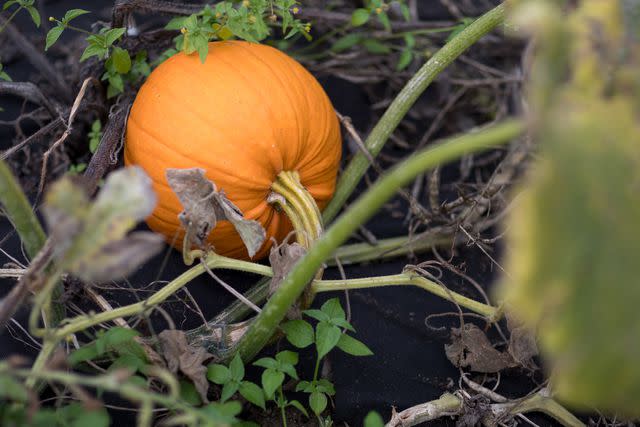When Should You Plant Pumpkins to Harvest for Halloween?
Days to Maturity and Climate Are Key Factors for the Planting Date

PhotoAlto/Jerome Gorin / Getty Images
Instead of making a trip to the pumpkin patch for Halloween, grow your own pumpkins. Since pumpkins are relatively easy to grow, it’s a great way to introduce children to gardening. You also don’t necessarily need a large yard to plant pumpkins. The standard vine-type pumpkins spread 25 feet or more in any direction but there are also small, semi-bush, and miniature pumpkin varieties. They are more compact and thus suitable for smaller spaces.
Here are tips about when and how to grow pumpkins for the Halloween harvest.
When to Plant Pumpkins for a Halloween Harvest
There are three main factors that determine when you should plant pumpkins for Halloween.
Seeds or Seedlings
It makes a difference whether you plant seedlings or plants from a nursery or start your own from seed. Purchased plants take the guesswork out of the timing; all you need to do is plant them after the last spring frost and take good care of them all summer. Then, the pumpkins should be ready to be harvested in time for Halloween. When starting pumpkins from seed, you need to do a simple calculation based on how long it'll take for the particular pumpkin variety to grow (learn more about that below).
Local Climate
The last frost date in your location is key for determining the planting time. Pumpkins are warm-season vegetables. The seeds need warm soil of at least 65 degrees F in order to germinate and the seedlings are sensitive to frost damage. For the seeds, the workaround begins with starting them indoors to get a head start on the growing season.
When planting, wait until there is no more danger of a late spring frost, which can be as late as the end of May in northern locations. If in doubt, it’s better to delay planting for a few days than to lose your plants. At the same time, you don’t want to delay the planting for too long, or else your pumpkins will not be ready to harvest when the first fall frost hits.
Extremely hot weather, on the other hand, is also detrimental to pumpkins. Therefore in southern locations, pumpkins are planted as late as early July to prevent them from maturing too early and rotting before Halloween.
Days to Maturity
Pumpkins take between 90 to 120 days to mature depending on the variety. Days to maturity means that you start counting the number of days from when the seeds germinate (not when you planted them).
For example, the popular Jack O' Lantern pumpkin takes 7 to 14 days to germinate and 100 to 110 days to maturity. That is a total of 124 days (roughly four months) from starting the seeds to harvesting the pumpkin. Assuming that your average last frost is in the first half of May and your average first fall frost is in early October, you should start the Jack O'Lantern from seed in late May or the very latest the first couple of days in June. That way, the four-month growing period is in the safe frost-free time window. In a northern climate with a short growing season, pick early-maturing varieties (around 90 days).
Halloween Pumpkin Varieties
There are lots of great choices for Halloween pumpkin varieties. Some compact varieties that are suitable for both decorating and carving include:
Autumn Gold an early-maturing semi-bush hybrid pumpkin. Its vines can reach 5 feet. Its fruit averages 12 to 18 pounds. It will take 70 to 75 days to maturity.
Magic Lantern is a semi-bush hybrid. Its vines can reach 4 to 5 feet. Its fruit averages 16 to 24 pounds. It will take 100 to 110 days to maturity.
Jack O'Lantern is a semi-bush heirloom. Its vines can reach 6 feet. Its fruit averages 18 to 24 pounds. It will take 100 to 110 days to maturity.
Blanco is a white hybrid bush pumpkin. Its vines can reach 4 to 5 feet. Its fruit averages 5 to 7 pounds. It will take 100 days to maturity.

tfoxfoto / Getty Images
Three Tips for Growing Pumpkins
Pumpkins only set fruit when they're pollinated by insects so make sure your yard is pollinator-friendly. Plant flowers to attract pollinators and do not use any wide-spectrum insecticides which will indiscriminately kill every insect.
Plenty of water and frequent fertilization is crucial for growing pumpkins. If there is not sufficient rain, at least water 1 inch per week slowly and deeply. Lack of water will result in a poor fruit set. For fertilizer, start with a high-nitrogen fertilizer (10-5-5) when the plants are about 1 foot tall and at bloom time, switch to a fertilizer that is high in phosphorus and potassium (5-15-15 ratio).
Once the plant starts blooming, there will be numerous flowers. To direct the plant’s energy into producing fewer but larger pumpkins, cut off some of the tiny pumpkins that start to form from female flowers.

Kevin Trimmer / Getty Images
How to Harvest Pumpkins
Rather than going by calendar date, inspect the pumpkins to determine if they are ready to be harvested. They should have a deep, solid color and a hard rind that does not dent when pressed with a fingernail. Another indicator is that the tendril closest to the pumpkin has turned brown (the vines have usually dried and shriveled at this point).
Cut the pumpkins off the vines with sharp pruning shears, leaving 3 to 4 inches of the stem attached.
Although pumpkins can survive a light frost, it is best to harvest them before the first fall frost.
Read Next: Tips for Growing Big Pumpkins

